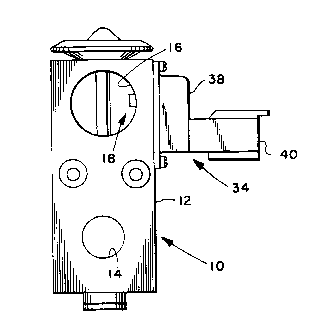Une partie des informations de ce site Web a été fournie par des sources externes. Le gouvernement du Canada n'assume aucune responsabilité concernant la précision, l'actualité ou la fiabilité des informations fournies par les sources externes. Les utilisateurs qui désirent employer cette information devraient consulter directement la source des informations. Le contenu fourni par les sources externes n'est pas assujetti aux exigences sur les langues officielles, la protection des renseignements personnels et l'accessibilité.
L'apparition de différences dans le texte et l'image des Revendications et de l'Abrégé dépend du moment auquel le document est publié. Les textes des Revendications et de l'Abrégé sont affichés :
| (12) Brevet: | (11) CA 2038385 |
|---|---|
| (54) Titre français: | CAPTEUR THERMOMETRIQUE POUR DETENDEUR THERMOSTATIQUE DU FLUIDE FRIGORIGENE |
| (54) Titre anglais: | SENSING REFRIGERANT TEMPERATURE IN A THERMOSTATIC EXPANSION VALVE |
| Statut: | Périmé et au-delà du délai pour l’annulation |
| (51) Classification internationale des brevets (CIB): |
|
|---|---|
| (72) Inventeurs : |
|
| (73) Titulaires : |
|
| (71) Demandeurs : | |
| (74) Agent: | BORDEN LADNER GERVAIS LLP |
| (74) Co-agent: | |
| (45) Délivré: | 1996-09-24 |
| (22) Date de dépôt: | 1991-03-18 |
| (41) Mise à la disponibilité du public: | 1991-09-20 |
| Requête d'examen: | 1993-10-21 |
| Licence disponible: | S.O. |
| Cédé au domaine public: | S.O. |
| (25) Langue des documents déposés: | Anglais |
| Traité de coopération en matière de brevets (PCT): | Non |
|---|
| (30) Données de priorité de la demande: | ||||||
|---|---|---|---|---|---|---|
|
A mechanical refrigerant thermal expansion valve has a
sensing port sealed with a cupped shape closure received
therein and sealed about the cup rim. A cover assembly is
removeably attached to the valve over the cup with a
thermistor extending into the cup which is filled with
thermally conductive grease for thermal conductivity
between the cup and the thermistor. The cover assembly
has an electrical connector provided thereon. The
thermistor is preferably mounted on printed circuit
board potted in the cover which may include electronic
signal logic and power switching circuitry.
Note : Les revendications sont présentées dans la langue officielle dans laquelle elles ont été soumises.
Note : Les descriptions sont présentées dans la langue officielle dans laquelle elles ont été soumises.

2024-08-01 : Dans le cadre de la transition vers les Brevets de nouvelle génération (BNG), la base de données sur les brevets canadiens (BDBC) contient désormais un Historique d'événement plus détaillé, qui reproduit le Journal des événements de notre nouvelle solution interne.
Veuillez noter que les événements débutant par « Inactive : » se réfèrent à des événements qui ne sont plus utilisés dans notre nouvelle solution interne.
Pour une meilleure compréhension de l'état de la demande ou brevet qui figure sur cette page, la rubrique Mise en garde , et les descriptions de Brevet , Historique d'événement , Taxes périodiques et Historique des paiements devraient être consultées.
| Description | Date |
|---|---|
| Le délai pour l'annulation est expiré | 2006-03-20 |
| Inactive : CIB de MCD | 2006-03-11 |
| Inactive : CIB de MCD | 2006-03-11 |
| Inactive : CIB de MCD | 2006-03-11 |
| Lettre envoyée | 2005-03-18 |
| Lettre envoyée | 2002-04-08 |
| Accordé par délivrance | 1996-09-24 |
| Exigences pour une requête d'examen - jugée conforme | 1993-10-21 |
| Toutes les exigences pour l'examen - jugée conforme | 1993-10-21 |
| Demande publiée (accessible au public) | 1991-09-20 |
Il n'y a pas d'historique d'abandonnement
Le dernier paiement a été reçu le
Avis : Si le paiement en totalité n'a pas été reçu au plus tard à la date indiquée, une taxe supplémentaire peut être imposée, soit une des taxes suivantes :
Veuillez vous référer à la page web des taxes sur les brevets de l'OPIC pour voir tous les montants actuels des taxes.
| Type de taxes | Anniversaire | Échéance | Date payée |
|---|---|---|---|
| TM (brevet, 7e anniv.) - générale | 1998-03-18 | 1998-02-05 | |
| TM (brevet, 8e anniv.) - générale | 1999-03-18 | 1999-02-03 | |
| TM (brevet, 9e anniv.) - générale | 2000-03-20 | 2000-02-04 | |
| TM (brevet, 10e anniv.) - générale | 2001-03-19 | 2001-02-19 | |
| TM (brevet, 11e anniv.) - générale | 2002-03-18 | 2002-03-06 | |
| Enregistrement d'un document | 2002-03-18 | ||
| TM (brevet, 12e anniv.) - générale | 2003-03-18 | 2003-02-13 | |
| TM (brevet, 13e anniv.) - générale | 2004-03-18 | 2004-02-11 | |
| TM (demande, 2e anniv.) - générale | 02 | 1993-03-18 |
Les titulaires actuels et antérieures au dossier sont affichés en ordre alphabétique.
| Titulaires actuels au dossier |
|---|
| PARKER-HANNIFIN CORPORATION |
| Titulaires antérieures au dossier |
|---|
| ROBERT J. TORRENCE |
| THOMAS F. GLENNON |